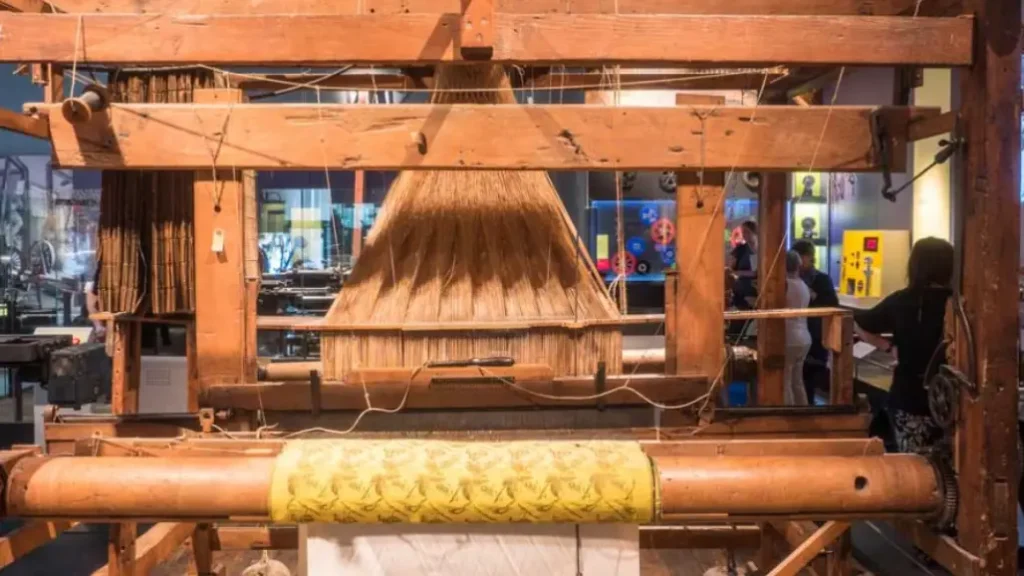Jacquard fabric, renowned for its intricate patterns and luxurious feel, is a testament to the artistry and ingenuity of weaving. Unlike printed or embroidered fabrics, jacquard patterns are woven directly into the fabric structure during the weaving process. This involves a complex interplay of threads, where some are raised to create the design while others remain submerged.
The creation of jacquard fabric is a fascinating blend of traditional craftsmanship and modern technology. This blog post will delve into the intricate process of jacquard weaving, exploring the key steps involved and the remarkable machinery that brings these stunning designs to life.
What Is Jacquard Fabric
Jacquard fabric is a type of woven fabric renowned for its intricate and elaborate patterns. Unlike printed or embroidered fabrics, these designs are woven directly into the fabric’s structure during the weaving process itself. This creates a unique, three-dimensional effect with raised and recessed areas that add depth and visual interest.
The name “jacquard” originates from Joseph Marie Jacquard, a French inventor who, in 1804, developed a revolutionary loom that automated the complex weaving process required to create these intricate patterns. This invention revolutionized textile production, enabling the creation of highly detailed and ornate fabrics that were previously impossible to produce on a large scale.
How is Jacquard Fabric Made
Jacquard fabric is a testament to the artistry and ingenuity of textile production. Its intricate patterns are not printed or embroidered onto the fabric, but rather woven directly into its structure using a specialized loom.

The Jacquard fabric manufacturing process involves several key steps:
Step 1: Jacquard Fabric Design Creation
The design process for jacquard fabric is a blend of artistry and technical expertise. Designers meticulously craft the intricate patterns that will be woven into the fabric, drawing inspiration from a variety of sources. These can include historical archives, natural elements like flowers and leaves, abstract concepts, and even contemporary art movements.
Skilled designers employ a range of techniques, including sketching, painting, and computer-aided design (CAD) software. CAD software allows for precise manipulation of lines, curves, and colors, enabling designers to experiment with different patterns and visualize the final fabric in 3D.
Once a design is finalized, it undergoes a critical stage known as “drafting.” This involves translating the artistic vision into a format that the Jacquard loom can understand. This typically involves creating a punch card or a digital file that contains the specific instructions for raising and lowering each warp yarn to create the desired pattern.
Step 2: Preparing the Loom
The Jacquard loom, a marvel of engineering, is a complex machine that requires meticulous preparation before weaving can commence.
The process begins with threading the loom with the warp yarns, which run lengthwise along the fabric. The number of warp yarns used can vary significantly depending on the complexity of the design. For intricate patterns with fine details, a greater number of warp yarns are required to achieve the desired level of precision.
Once the warp yarns are in place, the loom is programmed with the design information. Traditionally, this was accomplished using punched cards, where holes in the cards dictated the pattern. However, modern looms utilize sophisticated computer systems that can store and execute incredibly complex design files.
Step 3: The Jacquard Fabric Weaving Process
The weaving process itself is a mesmerizing display of intricate movements and mechanical precision. The weft yarn, which runs crosswise across the fabric, is interlaced with the warp yarns according to the instructions provided by the loom’s control system.
The heart of the Jacquard mechanism lies in a series of levers and hooks that control the lifting and lowering of individual warp yarns. This intricate system, often referred to as the “Jacquard head,” allows for the creation of intricate patterns with incredible accuracy.
As the weft yarn passes over and under the raised and lowered warp yarns, the pattern gradually takes shape. Each pass of the weft yarn adds another row to the growing fabric, creating a three-dimensional effect with raised and recessed areas that contribute to the unique texture and visual appeal of jacquard.
Step 4: Finishing
Once the weaving process is complete, the raw fabric undergoes a series of finishing processes to prepare it for its final use.
The first step typically involves washing the fabric to remove any residual sizing or impurities that may have accumulated during the weaving process. This is often followed by drying, which can be done by hanging the fabric or using specialized drying machines.
Depending on the desired properties of the final fabric, additional finishing treatments may be applied. These can include:
- Heat setting: This process involves applying heat to the fabric to improve its shape retention and wrinkle resistance.
- Special finishes: These can include treatments to enhance the fabric’s sheen, drape, or water repellency.
These finishing treatments contribute significantly to the overall quality and performance of the jacquard fabric.
Step 5: Quality Control
The final stage in the production of jacquard fabric involves a rigorous quality control process to ensure that the highest standards are maintained.
Experienced inspectors meticulously examine the fabric for any imperfections, such as uneven weaves, broken threads, or inconsistencies in the pattern. The fabric is carefully inspected for any defects that may affect its appearance, durability, or performance.
Only fabrics that pass this stringent quality control process are deemed acceptable and ready for use in a wide range of applications, including high-fashion garments, luxurious home furnishings, and other decorative items.
The creation of jacquard fabric is a testament to the artistry and ingenuity of textile production. From the initial design concept to the final inspection, each step in the process requires meticulous attention to detail, skilled craftsmanship, and a deep understanding of weaving techniques.
What is Jacquard Fabric Made Of
Jacquard fabric can be made from a wide variety of fibers, both natural and synthetic.
Synthetic fibers such as polyester, nylon, and rayon are also commonly employed in jacquard weaving. These synthetic options can offer increased durability, wrinkle resistance, and affordability compared to some natural fibers. Blends of natural and synthetic fibers are also often utilized to create jacquard fabrics with enhanced performance and a balance of desirable qualities.
Common natural fibers used to create jacquard include:
- Silk: Renowned for its luxurious sheen and drape, silk jacquard is prized for its elegance and often used in high-end fashion and home decor.
- Cotton: A more affordable option, cotton jacquard offers a comfortable and breathable fabric with good durability.
- Wool: Frequently used for heavier jacquard fabrics, wool provides warmth and insulation, making it suitable for winter clothing and home furnishings.
- Linen: Linen jacquard boasts a unique texture and a crisp, cool feel, making it popular for summer clothing and home decor.
Conclusion
The intricate beauty of jacquard fabric is a testament to the ingenuity of the weaving process. From the meticulous programming of the Jacquard loom to the skillful craftsmanship of the weavers, the creation of this remarkable fabric is a true art form. Understanding the complexities involved in its production allows us to appreciate the unique qualities and value of jacquard even more.
Ready to experience the exceptional quality of jacquard fabric firsthand? Fanda Fabrics offers a diverse selection of jacquard fabrics, all crafted with precision and care. We invite you to explore our collection and discover the perfect fabric for your next project.
Contact us today for a free quote on your desired jacquard fabric. Our knowledgeable team is ready to assist you in finding the ideal materials to bring your creative vision to life.
